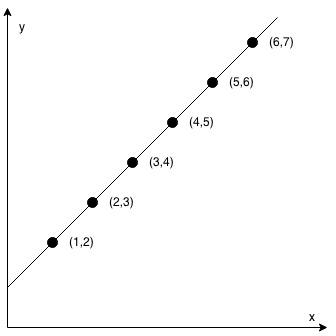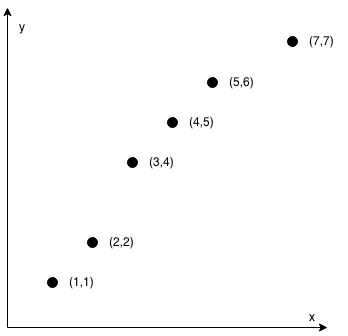- {x}
- Maximum Equal Frequency
- Report Contiguous Dates
- The Dining Philosophers
- Airplane Seat Assignment Probability
- Missing Number In Arithmetic Progression
- Meeting Scheduler
- Toss Strange Coins
- Divide Chocolate
- Check If It Is a Straight Line
- Remove Sub-Folders from the Filesystem
- Replace the Substring for Balanced String
- Maximum Profit in Job Scheduling
- Web Crawler
- Find Positive Integer Solution for a Given Equation
- Circular Permutation in Binary Representation
- Maximum Length of a Concatenated String with Unique Characters
- Tiling a Rectangle with the Fewest Squares
- Read More...

Check If It Is a Straight Line
You are given an array coordinates, coordinates[i] = [x, y], where [x, y] represents the coordinate of a point. Check if these points make a straight line in the XY plane.
Example 1:

Input: coordinates = [[1,2],[2,3],[3,4],[4,5],[5,6],[6,7]] Output: true
Example 2:

Input: coordinates = [[1,1],[2,2],[3,4],[4,5],[5,6],[7,7]] Output: false
Constraints:
2 <= coordinates.length <= 1000coordinates[i].length == 2-10^4 <= coordinates[i][0], coordinates[i][1] <= 10^4coordinatescontains no duplicate point.
Solution Explanation: Check If It Is a Straight Line
This problem asks whether a given set of points forms a straight line. The most efficient way to solve this is by leveraging the concept of slope. If all points lie on a straight line, the slope between any two points should be the same. However, we must handle the case where the line is vertical (undefined slope).
Approach:
-
Calculate the slope: We calculate the slope between the first two points. The slope
mis given by(y2 - y1) / (x2 - x1). -
Handle vertical lines: If
x2 - x1is 0 (vertical line), we check if all subsequent points have the same x-coordinate asx1. -
Check other points: For each subsequent point, we calculate the slope with respect to the first point. If this slope is different from the initial slope
m, the points don't form a straight line.
Time Complexity: O(n), where n is the number of points. We iterate through the array of coordinates once.
Space Complexity: O(1), as we use only a constant amount of extra space to store variables.
Code Implementation (Python):
class Solution:
def checkStraightLine(self, coordinates: List[List[int]]) -> bool:
x1, y1 = coordinates[0]
x2, y2 = coordinates[1]
# Handle vertical line case
if x2 - x1 == 0:
for i in range(2, len(coordinates)):
if coordinates[i][0] != x1:
return False
return True
# Calculate initial slope
m = (y2 - y1) / (x2 - x1)
# Check other points
for i in range(2, len(coordinates)):
x, y = coordinates[i]
if (y - y1) / (x - x1) != m: # Check if slope is consistent
return False
return True
Code Implementation (Java):
class Solution {
public boolean checkStraightLine(int[][] coordinates) {
int x1 = coordinates[0][0];
int y1 = coordinates[0][1];
int x2 = coordinates[1][0];
int y2 = coordinates[1][1];
//Handle vertical line case
if(x2 - x1 == 0){
for(int i = 2; i < coordinates.length; i++){
if(coordinates[i][0] != x1) return false;
}
return true;
}
double m = (double)(y2 - y1) / (x2 - x1); //Initial slope
for(int i = 2; i < coordinates.length; i++){
int x = coordinates[i][0];
int y = coordinates[i][1];
if((double)(y - y1) / (x-x1) != m) return false; //Check for consistent slope
}
return true;
}
}Code Implementation (C++):
class Solution {
public:
bool checkStraightLine(vector<vector<int>>& coordinates) {
int x1 = coordinates[0][0];
int y1 = coordinates[0][1];
int x2 = coordinates[1][0];
int y2 = coordinates[1][1];
//Handle vertical line case
if(x2 - x1 == 0){
for(int i = 2; i < coordinates.size(); i++){
if(coordinates[i][0] != x1) return false;
}
return true;
}
double m = (double)(y2 - y1) / (x2 - x1); //Initial slope
for(int i = 2; i < coordinates.size(); i++){
int x = coordinates[i][0];
int y = coordinates[i][1];
if((double)(y - y1) / (x-x1) != m) return false; //Check for consistent slope
}
return true;
}
};Code Implementation (Go):
func checkStraightLine(coordinates [][]int) bool {
x1, y1 := coordinates[0][0], coordinates[0][1]
x2, y2 := coordinates[1][0], coordinates[1][1]
//Handle vertical line case
if x2 - x1 == 0 {
for i := 2; i < len(coordinates); i++ {
if coordinates[i][0] != x1 {
return false
}
}
return true
}
m := float64(y2-y1) / float64(x2-x1) //Initial slope
for i := 2; i < len(coordinates); i++ {
x, y := coordinates[i][0], coordinates[i][1]
if float64(y-y1)/float64(x-x1) != m { //Check for consistent slope
return false
}
}
return true
}These code examples all implement the same core algorithm, adapting the syntax to their respective languages. They all achieve a time complexity of O(n) and a space complexity of O(1). Remember to handle potential division by zero errors (vertical lines) carefully as shown in the provided solutions.